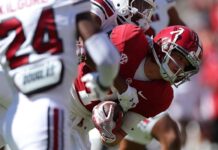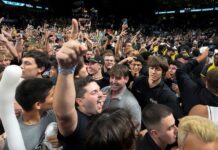[ad_1]
Lawyers representing the NCAA, its five power conferences and a class of Division I athletes on Friday filed detailed terms of an antitrust lawsuit that has the potential to reshape the business of college sports.
The parties agreed in late May to settle a trio of lawsuits (House v. NCAA, Hubbard v. NCAA and Carter v. NCAA) over the different ways schools compensate their athletes. Friday’s filing is the first of several important steps toward formalizing the deal. How past athletes will share the $2.78 billion in damages the NCAA has agreed to pay, sets up a new system for revenue sharing and outlines new roster limits for a long list of college sports, among other items.
“This is another important step in our ongoing efforts to provide increased benefits to student-athletes while building a stable and sustainable model for the future of college sports,” the NCAA and its power conferences said in a statement Friday evening. “While there is still much work to be done in the approval process of the settlement, it is an important step toward establishing clarity for the future of Division I athletics while maintaining a sustainable education-based model for college sports, ensuring the opportunity for students to earn a degree and continue to play sports. The tools needed to succeed later in life.”
Under the terms of the settlement, schools will be allowed for the first time to pay their athletes directly through name, image and similar (NIL) contracts. Each school can pay up to 22% of the average revenue that power conference schools generate from media rights, ticket sales and sponsorships — a sum that is expected to be $20 to $22 million per school if the settlement initially takes effect. of the academic year 2025-26.
Athletes will still be able to earn money from NIL contracts with third parties, but the NCAA said the settlement will allow them to install a more “robust and effective enforcement and oversight program” to ensure that third-party contracts are “valid NIL activities.” Athletes — especially in football and basketball — currently receive money from booster collectives, which act as outsourced salaries to attract top players rather than paying an athlete for actual value.The NCAA hopes its new system will do just that will reduce
The NCAA plans to create a database of NIL deals to attempt to objectively assess whether arrangements between an athlete and a third-party qualify as valid endorsement deals. Several coaches and athletic directors told ESPN last week that they expect some form of NIL payments from affiliates to continue in the future.
The settlement allows the court to appoint a “special master” to rule on any disputes over the new rules on player compensation. This marks a significant shift from the NCAA’s history of using its own enforcement arm to determine whether an athlete or school is violating its compensation rules. The settlement would also establish an arbitration process for players and schools to appeal any penalties under the new rules.
The two sides have yet to determine who will serve as the new enforcement entity or oversee any future dispute arbitration proceedings.
A figure of $20-22 million that effectively serves as the salary cap that will increase over time as the league’s revenue increases. Experts cited in court documents said they expect the cap number to rise to about $33 million per school by the end of the settlement’s 10-year term. Attorneys for the NCAA and the plaintiffs said those payments, when combined with the tuition and other benefits athletes already receive, would create a system in which many schools would share half of the revenue they generate with the athletes. This number is comparable to revenue sharing agreements in professional sports.
Steve Berman, co-chief counsel for the athletes, said their intent during negotiations was to reach a 50/50 revenue split.
“That’s what we had in mind, yes,” Berman said.
The 50/50 split calculation considers all of the school’s athletes as a team rather than by sport. For example, football players — who generate the bulk of revenue for most schools — are unlikely to receive 50% of the money the football team makes. Some of these benefits must be shared equally because of Title IX regulations. The settlement does not provide detailed guidance on how to apply Title IX to these new facilities, leaving some potentially complicated decisions to each individual school.
Law firms led by Berman and his co-chief counsel, Jeffrey Kessler, will be responsible for auditing the NCAA schools’ financial statements to ensure the schools are accurately reporting their revenue during the 10-year settlement.
As for past damages, plaintiffs’ attorneys submitted a proposed formula for deciding how to divide the money among eligible athletes. Any Division I athlete who played a sport from 2016 to present is eligible for past losses. The 2016 cut-off is due to the statute of limitations in the initial House v. NCAA lawsuit, which was filed in 2020. The formula takes into account many factors, including where the athlete went to school and how many snaps or minutes he had. they played
Berman said football and men’s basketball players at power conference schools will be eligible to receive an average of $135,000. Women’s basketball players from power conferences can earn an average of $35,000. Potential payouts for athletes in other sports will depend on how many enter the claim.
For some, part of the payout will be based on the athletes’ potential earning power if they are able to sign NIL contracts while in school. Berman said the highest individual estimated payout for an athlete would be $1.8 million.
As part of the settlement, the NCAA agreed to remove any limits on the number of scholarships a school can award athletes. Previously, NCAA rules dictated a certain number of scholarships per sport. If the settlement is approved, instead there will be a limit on the total number of players each team can have on its roster, and each individual school will decide how many of those players it wants to offer on scholarship.
Judge Claudia Wilken is expected to review the terms of the proposed settlement for the next few weeks and decide whether to accept them on a preliminary basis in early September or earlier. The settlement proposed that notice of the details of the settlement be sent to athletes on October 1, and that the window for athletes to object to its terms would be 105 days later on January 14.
Berman said the plaintiffs plan to release a website that would allow all athletes to determine how much money they could receive from the loss pool.
After the athletes have had an opportunity to review the terms, Judge Wilken will make a final ruling on whether to accept the settlement. That decision is not expected until late 2024 or early 2025.
[ad_2]











